We use cookies to make your experience better. To comply with the new e-Privacy directive, we need to ask for your consent to set the cookies. Learn more.
Short Lessons in Art History
Starting in the 14th century with the Italian Renaissance, this book proceeds chronologically along geographic lines, tracing the major art movements of their times. Just a sampling of artists included: Leonardo da Vinci, Michelangelo, Raphael, Dürer, Rubens, Rembrandt, Goya, Manet, Monet, Renoir, Matisse, Wyeth. Each chapter begins with general background information, followed by 2-4 pages of biography on each artist. Typeset is fairly small, so these are substantial overviews of their lives and works. Several black and white reproductions of their artwork are contained within. At the end of each biography are a few questions for discussion and a glossary to help with pronunciation or understanding. Color plates with 22 reproductions of paintings from the various artists are bound into the center of the book. As with most art history appreciation courses at this level, some illustrations have suggested nudity. Examples include, Eleven 11 A.M. by Edward Hopper (1926), Saint Martin and the Beggar ) (1597-1599), and Christ Cleaning the Temple (1570) by El Greco. If desired, pair this with the correlated Exercises and Activities book to extend your study into art! This reproducible book contains exercises and activities paralleling the study of each artist in Short Lessons. Each contains simple comprehension questions in the form of word puzzles, crosswords, matching, or fill in the blanks. Other questions require more careful thought on the part of the student, as they are asked to define terms, contrast artists' styles, etc. Longer "Writing Questions" call for independent writing or research. The student might be asked to construct a time line of the artists' major works, or describe how certain events influenced an artists' work. Answers to these questions and exercises are included. Finally, each section has a student project correlated to the artist under study. From sketching a scene Giotto might have drawn as a boy to constructing a Calder-inspired mobile, students create various art forms in the style of the artists under study, adding their own special touches as well. The components together would constitute a very complete art course.
| Product Format: | Softcover Book |
|---|---|
| Brand: | Walch Education |
| Author: | Phyllis Clausen Barker |
| Grades: | 6-12 |
| ISBN: | 9780825142451 |
| EAN/UPC: | 700507016671 |
| Length in Inches: | 10.75 |
| Width in Inches: | 8.5 |
| Height in Inches: | 0.5 |
| Weight in Pounds: | 1.2 |

